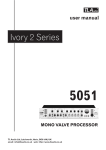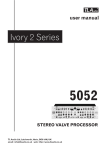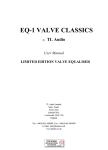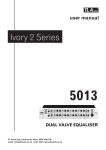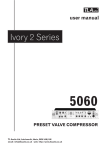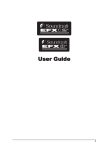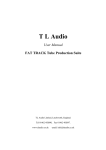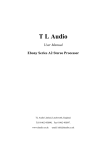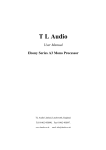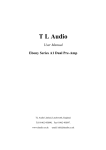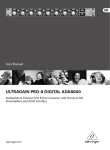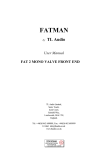Download TLA VP5051-2 manual - fra www.interstage.dk
Transcript
® TLAudio user manual Ivory 2 Series 5051 MONO VALVE PROCESSOR TL Audio Ltd, Letchworth, Herts, SG6 1AN, UK email: [email protected] web: http://www.tlaudio.co.uk CONTENTS 1 INTRODUCTION 2 PRECAUTIONS 3 INSTALLATION 3.1 3.2 3.3 3.4 3.5 3.6 3.7 3.8 A.C. Mains Supply Microphone Input Balanced Line Input Unbalanced Line Input Instrument Input Outputs Nominal Operating Level Ventilation 4 OPERATION 4.1 4.2 4.3 4.4 4.5 4.6 4.7 4.8 4.9 4.10 4.11 4.12 4.13 4.14 4.15 4.16 4.17 Input Stage What is Compression? Why Valve Compression? Overview of Compressor Operation Threshold Ratio Attack and Release Knee Gain Make Up Meter Compressor On Gate EQ Section EQ Pre Output Gain Stereo Link DO-2 Digital Output Option 5 GETTING STARTED 5.1 5.2 5.3 Connection In Use Frequently Asked Questions (FAQ) 6 SPECIFICATIONS 7 SERVICE 1. INTRODUCTION Congratulations on purchasing the Ivory 5051 Mono Valve Processor by TL Audio! The Ivory Series consists of a range of hybrid valve signal processors, which utilise low noise solid state electronics in conjunction with classic valve circuitry to produce audio processing units offering very high quality signal paths with the unique valve audio character. The units offer comprehensive control facilities, whilst remaining straightforward to operate, and represent excellent value for money. The 5051 is a single channel voice and instrument processor with mic, line and instrument inputs, a compressor, a four band equaliser and a noise gate. A single illuminated VU meter monitors the input level, output level or the compressor gain reduction. The optional DO-2 digital output card allows 24-bit analogue to digital conversion via an RCA phono type SPDIF output, with selectable 44.1 or 48 kHz sample rates and the option to clock the converter to an external word clock source. The block diagram of the 5051 is shown in Figure 1. A solid state, electronically balanced input amplifier is used to achieve state of the art performance with very low noise, low distortion and wide bandwidth. An ECC83/12AX7A triode valve stage (run from a stabilised 150v DC supply) is used as a second stage voltage amplifier, to obtain the classic valve sound and gradual overdrive characteristics. The preamp stage also features 48V phantom power, a 30dB pad and a high pass 90Hz filter. A Drive LED gives a visual indication of the signal level through valve stages (and thus the amount of ‘warming’ taking place) while a Peak LED warns that clipping is about to occur, and this monitors the signal at key points in the audio path. The compressor section offers fully variable control of threshold, ratio and gain make-up, with four switchable attack and release times and both hard and soft knee options. A ‘Hold’ facility reduces LF distortion, and a side chain insert point is provided for frequency conscious compression. Like all other TL Audio compressors, the gain control element of the 5051 compressor stage is based around a special transconductance amplifier, which avoids the use of VCAs and helps contribute to the smooth, open sound of the unit. A stereo link facility is provided to allow the compressor control voltages of two 5051s to be linked, thus preventing image shift when processing stereo signals. A four band valve EQ stage is included, providing up to 12dB of cut or boost and a choice of four pre-selected frequencies on each band. The ‘EQ PRE’ switch places the EQ ahead of the compressor in the signal path. A simple but effective noise gate (with variable threshold) is provided to remove unwanted background noise. Mic and line inputs are provided on electronically balanced XLR connectors, and the line input is duplicated on an unbalanced mono 0.25” jack connector. Balanced and unbalanced line outputs are provided (on XLR and jack respectively) and these can be used simultaneously. The operating level of the line input can be shifted from -10dB to +4dB (unbalanced) or +4dB to +18dB (balanced) via a rear panel switch, allowing the 5051 to accept very high levels - such as those from a digital recorder. A front panel instrument input is also provided, thus allowing guitars, basses and keyboards to feed directly into the 5051, removing the need for a separate DI box. Please read this manual fully before installing or operating the 5051. 2. PRECAUTIONS The Ivory 5051 requires very little installation, but like all electrical equipment, care must be taken to ensure reliable, safe operation. The following points should always be observed: - All mains wiring should be installed and checked by a qualified electrician, - Ensure the correct operating voltage is indicated on the rear panel before connecting to the mains supply, - Never operate the unit with any cover removed, - Do not expose to rain or moisture, as this may present an electric shock hazard, - Replace the fuse with the correct type and rating only. Warning: This equipment must be earthed. 3. INSTALLATION 3.1 AC Mains Supply. The unit is fitted with an internationally approved 3 pin IEC connector. A mating socket with power cord is provided with the unit, wired as follows: Brown: Live. Blue: Neutral. Green/Yellow: Earth (Ground). All mains wiring should be performed by a qualified electrician with all power switched off, and the earth connection must be used. Before connecting the unit to the supply, check that the unit is set for the correct mains voltage. The unit is internally set for 110-120V 60Hz or 220240V 50Hz operation, and should only be changed by an authorised service centre. The mains fuse required is 20mm anti-surge, 1AT rated at 250V. If it ever necessary to replace the fuse, only the same type and rating must be used. The power consumption of the equipment is 30VA. Warning: attempted operation on the wrong voltage setting, or with an incorrect fuse, will invalidate the warranty. 3.2 Microphone Input. The microphone input is via 3 pin female XLR connector, suitable for balanced or unbalanced microphones. The mating connector should be appropriately wired as follows for balanced or unbalanced operation: Balanced inputs: - Pin 1 = Ground (screen). - Pin 2 = Signal Phase (also known as “+” or “hot”). - Pin 3 = Signal Non-Phase (“-” or “cold”). Unbalanced inputs: - Pin 1 = Ground (screen) - Pin 2 = Signal Phase (“+” or “hot”). - Pin 3 = Signal Ground. 3.3 Balanced Line Input. The 5051 has a 3 pin XLR socket on the rear panel, which will accept both balanced and unbalanced line level inputs. The mating connector should be appropriately wired as follows: Balanced inputs: - Screen = Ground, - Tip = Signal Phase (“+” or “hot”), - Ring = Signal Non-Phase (“-” or “cold”). Unbalanced inputs: - Screen = Ground, - Tip = Signal Phase (“+” or “hot”), - Ring = Ground. When using unbalanced signals, the signal ground may be obtained by linking pins 1 and 3 in the mating XLR connector. If this connection is not made, a loss in level may result. 3.4 Unbalanced Line Input. An unbalanced line level input at a nominal level of -10dBu is also provided, on a 0.25” mono jack socket. The mating plugs should be wired as follows: - Tip = Signal Phase (“+” or “hot”). - Screen = Ground. 3.5 Instrument Input. Each channel has a 0.25” jack socket on the front panel (see Figure 2). A 2 pin (mono) jack plug is required, which should be wired as follows: - Tip = Signal Phase (“+” or “hot”), - Screen = Ground. 3.6 Outputs. The output is an xlr balanced output and also an unbalanced ¼” jack on the rear panel. Balanced operation is always preferable to maintain maximum headroom and signal to noise ratio, but can only be used if the following equipment is also capable of balanced operation: Balanced outputs: - Screen = Ground, - Tip = Signal Phase (“+” or “hot”), - Ring = Signal Non-Phase (“-” or “cold”). Unbalanced outputs: - Screen = Ground, - Tip = Signal Phase (“+” or “hot”), - Ring = Ground. 3.7 Nominal Operating Level. A switch on the rear panel allows the line inputs to be matched to equipment at a nominal operating level of +4dBu or -10dBu for unbalanced signals and +18dBu or +4dBu for balanced signals. Most professional equipment requires +4dBu (approximately 1.2V rms), but some small mixing consoles, portable tape recorders or domestic audio equipment require -10dBu (approximately 225mV rms). Digital multitrack recorders have very high signal levels due to the digital scale of 0dBFS usually matching +18dBu in the analogue domain. The 5051 is able to match the operating level of such recorders. If the operating level is not known, the switch should be set to the position which FIG 2: FRONT PANEL EQUALISER FREQUENCY SWITCH INPUT SELECTOR SWITCH INPUT MIC COMPRESSOR ATTACK LINE MIC 48V SLOW INST EQUALISER RELEASE FAST 120 SLOW FAST 60 HARD SOFT MIC -30dB INPUT IVORY LINE 0dB THRESHOLD 0 RATIO 1:5 1:10 INSTRUMENT GAIN MAKE-UP 5 500 500 METER 2K2 2K2 3K6 1K5 Hz 5K 5K LM 0 8K 2K2 Hz LF 0 GATE -40 1K 250 Hz KNEE 12 250 VU METER O/P 12K O/P+10 G/R I/P 5051 Hz HM 0 HF 0 MONO VALVE PROCESSOR OUTPUT 0 -20 EQ ON 16 dB 60 DRIVE 90Hz +20 dB -20 1:1.5 1:30 0 OFF dB -10 dB 20 PEAK COMP ON INSTRUMENT INPUT COMPRESSOR CONTROLS INPUT GAIN CONTROL -12 dB +12 -12 dB +12 -12 dB +12 -12 dB +12 EQ PRE LINK - oo dB +15 SHUT POWER GATE THRESHOLD CONTROL EQUALISER CUT/BOOST CONTROL OUTPUT LEVEL CONTROL FIG 3: REAR PANEL SAMPLE RATE SELECTOR SWITCH (OPTIONAL)* DIGITAL OUTPUT (OPTIONAL)* WARNING - ATTENTION THIS APPARATUS MUST BE EARTHED. FOR CONTINUED PROTECTION AGAINST RISK OF FIRE, REPLACE ONLY WITH SAME TYPE AND RATING OF FUSE. UTILISER UN FUSIBLE DE RECHANGE DE MEME TYPE ET CALIBRE W/CLOCK INPUT (OPTIONAL)* SPDIF OUTPUT RISK OF ELECTRIC SHOCK DO NOT OPEN 5051 MONO VALVE PROCESSOR ATTENTION kHz 44.1 Manufactured by TL Audio Limited, England. CAUTION W/CLOCK IN 48 SERIAL NUMBER RISQUE DE CHOC ELECTRONIQUE NE PAS OUVRIR +4dBu BALANCED OUTPUT INSERT: TIP = SEND, RING = RETURN, BALANCED INPUT MIC INPUT SLEEVE = GND. FUSE T1AL 250V 230V~25VA 115V~25VA WARNING TO REDUCE THE RISK OF FIRE OR ELECTRICAL SHOCK, DO NOT EXPOSE THIS EQUIPMENT TO RAIN OR MOISTURE -10dBu UNBALANCED S/CHAIN INSERT LINK JACK: TIP = +VE, SLEEVE = GND. LINK: TIP = +VE, SLEEVE = GND. NOTE: CONNECT TO SECOND 5051 LINK SOCKET ONLY. XLR: PIN 1 = GND, PIN 2 = +VE, PIN 3 = -VE. IEC INLET LINE OUTPUTS SIDECHAIN INSERT POINT CONNECTOR * VIA DO-2 DIGITAL OUTPUT CARD INPUT LEVEL UNBALANCED INPUT -10dBu +4dBu +4dBu +18dBu INPUT LEVEL SWITCH STEREO LINK CONNECTOR INPUTS results in the best signal to noise ratio and least noise while being able to handle high signal levels. 3.8 Ventilation. The 5051 generates a small amount of heat internally, mainly due to the valve heater. This heat should be allowed to dissipate by convection through the side grills, which must not be obstructed. Do not locate the 5051 where it will be subject to external heating, for example, in the hot air flow from a power amplifier or on a radiator. 4. OPERATION 4.1 Input Stage. The Input Gain control sets the level of the signal whether mic, line or instrument into the 5051. The signal source is selected by the 4-position switch above the Input Gain knob. Input choices are Mic 48v (for condenser microphones that require phantom power), Mic (for dynamic or most ribbon microphones), Line and Instrument. The Instrument input allows high impedance instruments such as guitars or a bass etc to connect directly into the 5051 and eliminates the need for a Direct Injection Box. A wide range of signals can be fed into the 5051, and the Input Gain control also allows the valve stages to be driven to a variable degree. After the preamp stage the signal passes through a triode valve stage positioned between the input circuit and the compression stage. Increasing the input gain pushes more signal level into the valve, thus generating more harmonic distortion and creating that special “valve sound”. This is indicated by the yellow drive led which will glow more intensely as the level increases. At the same time the output level can be turned down to preserve the same level at the outputs, so a choice of sounds is available. For a more pronounced valve sound, turn up the input gain and reduce the output gain, and vice versa for a cleaner sound. Don’t be afraid to push the 5051 hard! As well as driving the valves harder, increasing the Input Gain control will also have a pronounced effect on the amount of compression threshold will remain constant as the input level increases. If the input adjusted the threshold can be adjusted accordingly to maintain a amount of compression. 4.2 setting as the gain is similar What is Compression? Compression is an essential but often misunderstood process in modern recording. Put simply, compression reduces the difference between the loudest and the quietest levels of an audio signal. This is known as reducing the “dynamic range” of that signal and is a powerful tool for an engineer helping to avoid overloading, distortion problems as well as raising the level of the quieter parts of the audio signal. Before the introduction of compressors the only way this could be achieved was by “gain riding”, whereby an engineer would control the fader manually in order to try and anticipate very large levels (which might distort the signal) or very low levels (which may get lost in noise). The introduction of compression devices meant that this process could be controlled automatically, allowing the engineer to get on with more productive jobs! Many instruments and voices have a very wide dynamic range that need to be controlled. A singer, for instance, may be singing quietly one moment and very loudly the next, and unless compression is applied the vocal won’t “sit” correctly in the mix, in addition to the problems of distortion on loud passages and noise on quiet ones. Compressors effectively turn down the loud bits and turn up the quiet bits, to achieve a more even and controllable level. Compressors are often judged by their ability to control the dynamics without creating noticeable audible side effects. Heavy compression can cause the signal to pump or breathe with the onset and release of the compression. Some compressor designs can dull the signal and lose the top end of the signal. The 5051 compressor design, as with other TL Audio compressors, uses a technology based around a transconductance amplifier rather than a VCA design. This transconductance amplifier design is known for being able to retain the full frequency range and natural character of the audio signal, even when compressing the signal quite heavily. The Ivory 2 5051 is also capable of more severe compression based around the optional Hard Knee mode if this is desired. There are other benefits of compression as well as just controlling the peaks and raising the quiet parts, applied properly, it can add punch and excitement to music, as well as fattening up sounds and creating a more professional sounding recording. With the 5051, you have the added benefit of valve stages in the signal path, which create a warmth and presence just not obtainable with solid state or digital products. 4.3 Why Valve Compression? Valve compression yields a particularly special sound which has become very sought after, particularly with the widespread use of digital products. The reason valve equipment sounds special is due to two things: harmonic distortion and natural compression. When the signal through a valve is increased, it tends to generate a particular type of subtle and desirable distortion, called “second harmonic” distortion. This has the effect of thickening and warming the sound, and the more the level you feed to the valve stages, the more of this harmonic distortion will be produced. You should be able to hear this effect as you increase the Input Gain on the 5051. Secondly, valves will tend to naturally compress an audio signal, again particularly as the signal level is increased. This itself also contributes to the warmth produced by the 5051. 4.4 Overview of Compressor Operation. To operate the 5051 successfully an understanding of each control will help to obtain the best results. If you are unfamiliar with the effect of compression it may help to adjust the controls to extreme settings and listen to the sonic effect. Compressors can either be used to enhance the signal and control the dynamic range with as little sonic effect as possible, or they can be used more severely specifically for effect. 4.5 Threshold. The Threshold is the point measured in decibels that any compression comes into operation. The Threshold control is variable from +20dB in the most anticlockwise position to -20dB at the most clockwise position. Any signal below the Threshold passes through the unit unaffected; while signals above the Threshold are reduced in gain (and are thus ‘compressed’). This does depend on the Soft or Hard knee to some extent as the Soft knee is more gradual around the Threshold point. Unlike some compressors, the Threshold control on TLA units including the 5051 starts at a ‘plus’ value in the counter-clockwise position, and decreases to a ‘minus’ value as you rotate the control clockwise. The reason for this is as you turn the Threshold control on the 5051 clockwise (i.e. towards the negative region) then the degree of compression will increase. We think this is logical, whereas the common method of turning the control ‘down’ to achieve more compression is not - but beware, some other compressors may work in the opposite direction! 4.6 Ratio. Once the input signal has crossed the threshold, the degree of gain reduction is determined by the Ratio control. The Ratio control is calibrated in decibels and is simply the change in output level that results from a given change in input level. An uncompressed signal will have a 1:1 compression ratio - every 1dB change in input level results in the same 1dB change in output level. A compression ratio of 1:3, for instance, means that a 3dB change in input level will only give a 1dB change in output level. For more severe compression, simply turn up the Ratio control. The 5051 offers a wide range of ratios from 1:1.5 (gentle compression) through to 1:30 (limiting). Limiting effectively clamps the input signal at the threshold level no matter how much the signal is increased: this can be useful when trying to ensure that the signal doesn’t exceed a certain level - for instance to prevent a digital recorder distorting through overload. 4.7 Attack and Release. The Attack and Release settings allow a choice of four positions between slow and fast. The Attack is how quickly the compression is applied once the Threshold has been exceeded. The Release is how quickly the compression is released. There is an element of automatic Attack and Release on the 5051 to cope with sudden transient signals. The speed of the Attack and Release should be able to work with the tempo of the signal. For example if the signal is a snare drum, by monitoring the gain reduction it is possible to set the Release to allow the compression to fully recover (the gain reduction needle will settle back to 0dB) before the following snare beat. This prevents the oncoming snare beat from having a reduced gain to the first snare beat. One side effect of having an incorrect Release setting is distortion on low frequency signals. This is due to the Release changing gain to quickly for the large low frequency waveforms. To cure this problem the Release can be slowed down. 4.8 Knee. The Knee switch enables the 5051 to be operated in two different modes - Soft Knee or Hard Knee. Soft Knee mode offers a gentle compression curve around the Threshold point, and is traditionally employed to yield a more subtle, musical type of compression effect. The Hard Knee setting causes the full compression ratio to be applied immediately the signal has passed the Threshold point, so tends to produce more pronounced and severe compression. 4.9 Gain Make Up. While the subjective sound quality of the signal can be improved by compression, the overall signal level will be reduced when gain reduction is taking place. The Gain Make Up control is designed to boost the compressed signal by between 0 and 20dB, in order to bring back the level to the same loudness as the uncompressed signal. Without this control, comparing the original and compressed signals becomes difficult, since there would be a level drop each time the compressor is switched in: therefore it is normal to adjust the Gain Make Up control so that when the ‘compressor on’ switch is activated, the audio signal remains constant in level. Unlike the Output Level control, the Gain Make Up control is active only when the ‘compressor on’ switch is engaged. Once the Gain Make Up has been adjusted, use the Output Level control to set the overall output level of the 5051. 4.10 Meter. The 5051 is equipped with an illuminated VU meter. The Meter switch enables the 5051 VU meter to monitor each one of four parameters. When switched to ‘Input’ the meter reads the audio input level. When switched to ‘Output’ the meter reads the audio output level, and is calibrated to read 0VU for a +4dBu output level. When switched to ‘Output + 10’ the meter reads 10dB below the audio output level. Increasing the Output Level control on the 5051 towards the +15dB setting will cause the 5051’s meter to move further towards the red area and possibly to the end of the scale if sufficient gain is applied. The ‘Output +10’ setting can be selected to prevent the VU needle from pressing constantly at its end stop. This is normal, particularly if driving a digital recorder where large input levels are required. The meter when switched to ‘GR’ (Gain Reduction) indicates the amount of compression occurring. If the signal is below the threshold, the meter will indicate 0dB: i.e. no gain reduction. As the signal passes through the threshold, the meter will start to indicate the gain reduction at the compressor stage (this will be a negative value, so the meter will move to the left, away from 0VU). Note that this reading won’t include any extra gain make-up applied. 4.11 Compressor On. This switch enables or disables the compressor stage, thus allowing an A/B comparison to be made between the original untreated signal and the compressed signal. An associated status LED indicates when the compressor is active. The 4th position Gain Reduction on the VU meter will monitor the level of compression regardless of the compressor stage being active or non active. 4.12 Gate. What is a gate and how do I use one? A gate (or noise gate) is a device that can completely shut off or mute the signal path. The point at which the 5051 gate will shut is based on the level of the signal falling below an adjustable threshold point. Gates are commonly used to shut out background noise or hiss from noisy signals or to isolate a louder signal from other quieter signals. An example of this would be when miking up a drum kit with a number of individual mics on specific drums. Each mic will pick up not only the drum it is directly miking but also all the neighbouring drums. By gating out the quieter neighbouring drums each drum track can be “cleaned up”. The trick to using the gate successfully is to adjust the threshold to the point where the desired signal opens the gate and the undesirable signal is below the threshold point and is gated out. This is never an easy task as the threshold point remains constant but the point between desirable signal and undesirable signal is constantly changing. Gating can be a tricky process to get right as success depends a great deal on the signal characteristics. The gate on the 5051 is situated before the compressor stage and has a red led indicating when the gate is active or shut. At fully anti-clockwise the gate is at its off position and is completely inactive. Turning the gate clockwise towards the -10dB maximum setting raises the threshold point so that the signal needs to be increasingly louder (as the threshold is raised) to open the gate. At the lowest setting, just above the off position, low level signals such as background noise can be gated. Raising the threshold point by turning the gate control clockwise allows gating of higher level signals such as drums. If you are having trouble selecting the threshold point one tip is to select different threshold points suitable for specific parts of the signal and mark them with a chinograph pencil. For example the intro to the signal may be quite strong so the threshold can be set quite high and the end of the signal may have a gradual fade out so the threshold can be adjusted to suit this ending. This of course is only possible with recorded signals where the track can be constantly replayed to practice the settings. 4.13 Equalisation. The 5051 equaliser section has four bands, each with continuously variable cut and boost control. Each band has a four position switch to select the nominal corner frequency for the shelving bands (LF and HF), or centre frequency for the peaking mid-bands. The Q or bandwidth of the equalisers is approximately 0.5, allowing a good degree of overlap between bands. LF Band. The LF (Low Frequency) band of the equaliser has a shelving characteristic i.e. it extends from the selected frequency to the extreme low frequency limit of the equaliser’s response. The corner frequency of the LF band is selected by a rotary switch from 60Hz to 500Hz, and the cut or boost is controlled by a continuously variable, centredetented rotary knob. At the selected corner frequency, up to 12dB of cut and boost are available. Typical response curves are shown in the specification section of this manual. LM Band. The LM (Low-Mid Frequency) band has a peaking characteristic - i.e. it boosts or cuts a section of the audio spectrum around its selected centre frequency only. The centre frequency of the LM band is selected by a rotary switch from 250Hz to 2K2Hz. The mid bands possess a fairly low Q value of approximately 0.5, for a response which results in effective equalisation without harshness. The amount of cut or boost is again controlled by a continuously variable, centre-detented rotary knob, with up to 12dB of cut and boost available at the centre frequencies. Response curves for the mid bands are also shown in the specification section of this manual. HM Band. The HM (High-Mid Frequency) band is similar in operation to the LM band, except that the centre frequencies are obviously higher and concentrated in the critical upper vocal region of the spectrum. The available frequency range is 1K5Hz to 5 KHz. HF Band. The HF (High Frequency) band has a shelving characteristic, complimenting the LF band. Corner frequency selection is by rotary switch from 2K2Hz to 12 KHz. Bypass. The Equaliser In switch allows the processing to be bypassed for comparison of the equalised and original, unprocessed signal. 4.14 EQ Pre. The pre switch places the equaliser ahead of the compressor section. Depending on the EQ settings, the compressor performance will be affected. The compressor can be made to be frequency conscious as it will react to any frequencies primarily if they have been boosted. The effect may be compared by toggling the pre switch. 4.15 Output Gain. This controls the level at the 5051output. The nominal level is 0dB at the centre detented position. This control effectively acts like an output fader, and is very useful when recording direct to tape or hard disc through the 5051. You may find that some digital recorders require a good deal of input level in order to register a 0dB reading on their meters (+18dBu analogue usually matches 0dBFS in the digital scale). This is normal, since many digital recorders are designed to preserve headroom and keep the signal well below the 0dB clip point - thus preventing the recorder distorting. The 5051 provides a further 15dB of gain at the output fader to drive digital recorders. It is important to distinguish the difference between the output gain knob and the gain make-up knob in the compressor section. The gain make-up control is only active when the compressor is switched on. The output gain control is always active but will have no effect on the compression characteristics of the signal. 4.16 Link. The Link switch allows the compressors from two units to work in stereo mode and is typically used when two 5051’s are used for stereo processing of signals such as for a mix. Stereo linked compression is important to avoid imbalances in the stereo signal or “dips” to appear on one side of a stereo signal if a peak triggers the threshold on one side only. If compressors are not linked for stereo signals the “dipping” of one channel can sound very obvious and unnatural. In stereo linked mode if the signal reaches the lowest threshold on one of the 5051’s, both channels will react together. At the rear of the unit a link socket allows a mono 1/4” jack cable to be connected from the link connection on one 5051 to the link connection on another 5051. Both Link switches on both units need to be switched on. In stereo operation all the controls remain independent so will need to be set identically on both 5051’s 4.17 Digital Output. The digital output is an option for the Ivory 2 5051. The card converts the analogue signal at 24-bit resolution and is selectable to 44.1 or 48 kHz sample rates. The digital connector is a coaxial SPDIF format on an RCA phono type connector. The card also has a word clock BNC connector for clocking to an external digital source. This is useful for ‘slaving’ the 5051 A/D card to an existing digital setup without the 5051 needing to be the digital master in the system. 5. GETTING STARTED 5.1 Connections. There are various ways that the 5051 can be connected into your audio system. The three most common are: a) As an instrument front end b) Connected to a channel insert point on a mixing desk c) Connected to a group or master insert point on a mixing desk To use the 5051 as an instrument front end, connect the output of the 5051 directly to the line (not mic) input of your console, recorder or sound card. A common mistake is to plug the xlr output to the xlr Mic input on a console. This is incorrect and will cause the console mic inputs to overload very easily. The 5051 has balanced line outputs for professional sound quality, but can easily connect to an unbalanced line input (see Installation section 3.2). If using the balanced output the following item of equipment also needs to have balanced inputs. Once the output is connected, simply feed your instrument into the front panel jack input on the 5051. Recording direct to the multitrack recorder (thus bypassing the console) is a common technique these days as it keeps the signal path short, and of the highest quality. No unnecessary console stages are passed through, thus maintaining quality. Many mixers have sockets called ‘insert points’, which allow processors such as dynamics devices and EQs to be patched in-line into the mixer signal path at various points. An insert point usually sends the input signal out directly after the mixers preamp gain control and then the signal is connected into the processor (such as the 5051) and then returns the processed signal back to the mixer at the same point in the signal path. This is commonly achieved using a special insert cable (sometimes known as a Y lead or split lead) where the cable is usually a stereo or TRS ¼” Jack connector split to two mono connectors, one for send and one for return. The most likely positions that insert points are located on a mixer are in the channel, group and stereo master sections. Patching the 5051 into the channel insert point means that any signal passing through that channel will pass directly though the 5051. Compressing and Eq’ing a vocal, for instance, can be achieved by connecting the microphone directly to the console mic input, then connecting the 5051 into the console insert point. The mic signal will be amplified by the mixer before being passed into the 5051’s input via the mixer insert ‘send’ connection. The output of the 5051 connects back to the insert ‘return’ connection, thus returning the signal to the mixer and ensuring continuous signal flow. Group insert points are used to process sub-grouped signals such as drums or backing vocals. It’s common to mix an entire drum kit to a stereo group, and then use a pair of group faders to control the overall level, rather than having to adjust each individual drum level. If you then wish to compress the overall stereo kit signal, you can connect two linked 5051’s to the relevant group insert points, using the same ‘send and return’ technique as the channel insert. Having processed individual tracks while recording, it is common to apply some processing to the stereo mix while mastering it to 2 track tape, DAT or CDR. Doing this will help fatten the sound further and control levels. Like the channel and groups, the stereo L/R mix buss will normally have a pair of insert points to facilitate this. If not, the 5051 can be connected in-line with the mixer’s main stereo outputs, ahead of the master 2 track recorder. The latter method may be preferable as this allows the processors to be connected with balanced connectors (the insert points are usually unbalanced). Connecting the 5051 to the main insert point does allow the processing to be monitored as the processor is looped into the output stage of the mixer. If the 5051 is connected in line, to hear the results of the processing the 2 track mastering machine needs to be monitored. This is possible by connecting the mastering recorder to the mixer’s 2-track return and monitoring the 2-track return on the mixer. The optional digital output will allow a mono high quality A/D conversion at 24bit from the 5051 Mk-2 on a coaxial SPDIF output. The digital connector allows a digital input into digital recorders such as Digital Multitrackers, Hard Disk Recorders, DAT Recorders, Minidisk and CD-Recorders. The Ivory converter may be preferable to using the converters on the digital recorder. When connecting the SPDIF connector it is advisable to use cables less than 5 metres in length and of high quality. The digital output can be used simultaneously with the analogue outputs. 5.2 In Use. Having connected the 5051 checking that the operating level switch is at the most suitable setting (see section 3.5), it’s time to put it into action! Here’s a simple step by step guide: 1. The first stage is to set up the gains of the unit. With all the processing (compressor, gate and EQs) switched out, start with the Input and Output Gains and Gain Make-Up at 0dB. 2. With the Meter set to read ‘Output’, adjust the Input Gain to achieve a peak reading of around 0VU with the chosen source material. 3. If more output is then required then adjust the Output Level control accordingly. Beneath the Input Gain there is a red “Peak” led. This lights up to warn that the signal is 5dB below clipping. The “Peak” meter does monitor both the input stage and the output stage. If the “Peak” led is lighting up when the Output Gain and Gain Make-Up (this only applies if the compressor is turned on) are very low this means the Input Gain may be set to high. Alternatively if the “Peak” led lights up when the Input Gain is low then the Gain Make-up or the Output Level control is too high. The “Peak” led lighting up is not necessarily a problem it is a warning that the levels are close to clipping 4. Now depress the Compressor ‘On’ switch, and select the Meter switch to read GR (Gain Reduction). 5. Using the compressor’s controls you will need to adjust settings to suit the instrument you are listening to. 6. The meter should now register that some gain reduction is taking place. If not, or you wish more gain reduction to occur this can be achieved in a number of different ways 7. When gain reduction is taking place, you should notice that the output level is reduced. By switching the compressor on switch in and out, you can compare the levels and the subjective sound quality of the original and compressed signals. With the compressor active, use the Gain Make-Up control to set the level so that when disabling the compressor, there is no level drop. This way you can A/B the signals without the levels changing. 8. With the Compressor switched on you can now adjust the Threshold, Ratio, Attack, Release and Knee controls. Start with the Threshold at +10dB, Ratio at 1:3, Attack and Release at ‘Fast’, and Knee at ‘Soft’. 9. While continuing to meter gain reduction, gradually turn the Threshold clockwise towards -20dB. While doing this you’ll notice that compression will start to take place and the meter will start to register some gain reduction. The further towards -20dB you move, the greater the gain reduction that occurs. Aim to get around a maximum 3-4dB of gain reduction occurring as a starting point. You should also notice that increasing the Ratio setting causes more gain reduction to occur. 10. At this stage if you are unfamiliar with compression you should experiment with each control to see how it affects the sound. Until you are familiar with using compressors it can be difficult to hear these changes as a good compressor will retain the natural sound of the source signal. If in doubt aim to use compression gently as over compressed signals cannot be uncompressed. On the other hand there are no rules on how to use compression so absolute max settings may be the effect you are after, the choice is yours. 6. SPECIFICATIONS Microphone Input: Phantom Power: Line Inputs: level. Gain range +16dB to +60dB, Noise -127dBu (EIN with 150 ohm source, 22Hz - 22KHz and maximum gain), Switchable 30dB pad, Maximum input level +4dBu (+30dBu with pad). +48V at 10mA maximum. Balanced XLR, switchable +4dBu/+18dBu nominal Unbalanced jack, switchable -10dBu/+4dBu nominal. Gain range +/-20dB. Maximum input level +26dBu. Instrument Input: Via front panel 0.25” jack socket, Input Impedance 1Mohm, Gain range -2dB to +38dB, Maximum input level +10dBu. High Pass Filter: -3dB at 90Hz, 12dB per octave, Active on all inputs. Outputs: Balanced XLR, nominal level +4dBu, Unbalanced jack, nominal level -10dBu. Output Gain Control: Rotary fader, +15dB maximum gain. Maximum Output Level: +26dBu (XLR), +12dBu (Jack). Gate: Threshold variable -60dBu to -10dBu. Compressor: Threshold -20dBu to +20dBu, Attack 0.5msec to 40msec, Release 40msec to 4 seconds, Ratio 1:1.5 to 1:30, Hard / Soft Knee switch, Gain Make-Up 0 to +20dB. Equaliser: LF Band: +/-12dB at 60Hz to 500Hz. Shelving response. LM Band: +/-12dB at 250Hz to 2K2Hz. Peaking response, Q = 0.5. HM Band: +/-12dB at 1K5Hz to 5KHz.. Peaking response, Q = 0.5. HF Band: +/-12dB at 2K2Hz to 12KHz. Shelving response. Drive LED: Increasing intensity to reflect valve drive, commencing at +4dBu to full brightness at +14dBu (Output level control at 0dB). Peak LED: +20dBu. Monitors Input and Output Levels. VU Meter: Switchable to Input level, (0VU = +4dBu), Output level, (0VU = +4dBu), Output +10dB, (0VU = +14dBu), Gain Reduction (Compression). Frequency Response: Distortion: “Drive” 10Hz to 40KHz, +0, -1dB. Predominately second harmonic, increasing with level. Typically 0.2% @ 0dBu. Noise: -80dBu, 22Hz to 22KHz, line input selected at 0dBu input and output gain, Compressor and EQ on at 0dB. Dynamic Range: 106dB (Line input @ 0dB gain). Sidechain Insertion Points: Unbalanced, switched 3 pin jack socket, tip = send, ring = return, Nominal level -2dBu, Output impedance 47 ohms, Return input impedance 10Kohms. Power Requirements: operation, Internally set to 230V 50Hz or 115V 60Hz Detachable IEC power cord, Power consumption 25VA typical. Dimensions: 19” rack mounting, 2U high. W x D x H = 483 x 88 x 200mm (19.0” x 7.9” x 3.5”). Shipping Weight: . 7. SERVICE 6 kgs. Should the 5051 require service, it must be taken or posted to an authorised dealer with a description of the fault. Please retain the original packing for possible future use, and ensure the unit is suitably protected during transit. The manufacturer cannot accept responsibility for damage caused during transportation. The 5051 is supported by a limited warranty for a period of one year from the date of purchase. During this period, any faults due to defective materials or workmanship will be repaired free of charge. The warranty excludes damage caused by deliberate or accidental misuse, tampering, operation on the incorrect mains voltage, or without the correct type and value of fuse fitted. It is the user’s responsibility to ensure fitness for purpose in any particular application. The warranty is limited to the original purchase price of the equipment, and excludes any consequential damage or loss. When claiming service under warranty, proof of purchase date must be included with the equipment for repair. Please record the following details, and retain proof of purchase: Serial Number............................. Date purchased........................... Dealer.........................................
























